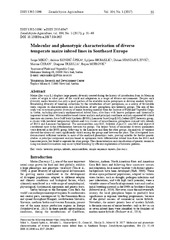Приказ основних података о документу
Molecular and phenotypic characterisation of diverse temperate maize inbred lines in Southeast Europe
| dc.creator | Mikić, Sanja | |
| dc.creator | Kondić-Špika, Ankica | |
| dc.creator | Brbaklić, Ljiljana | |
| dc.creator | Stanisavljević, Dušan | |
| dc.creator | Ćeran, Marina | |
| dc.creator | Trkulja, Dragana | |
| dc.creator | Mitrović, Bojan | |
| dc.date.accessioned | 2021-04-26T19:33:54Z | |
| dc.date.available | 2021-04-26T19:33:54Z | |
| dc.date.issued | 2017 | |
| dc.identifier.issn | 1392-3196 | |
| dc.identifier.uri | http://fiver.ifvcns.rs/handle/123456789/1689 | |
| dc.description.abstract | Maize (Zea mays L.) displays large genetic diversity created during the history of introduction from its Mexican centre of origin to other parts of the world and adaptation to a range of diverse environments. Despite such diversity, maize breeders use only a small portion of the available maize germplasm to develop modern hybrids. Broadening diversity of breeding collections by the introduction of new germplasm, as a source of favourable traits, requires its characterisation and classification of new germplasm into heterotic groups. The aim of this study was to estimate genetic diversity of maize breeding material from the Institute of Field and Vegetable Crops in Serbia, including previously uncharacterised inbred lines, elite lines with known pedigrees and historically important inbred lines. Microsatellite-based cluster analysis and principal coordinate analysis separated 96 inbred lines into six clusters, Iowa Stiff Stalk Synthetic (BSSS), Lancaster Sure Crop (LSC), Iodent (IDT) heterotic group, a cluster with unrelated independent inbreds and two clusters of miscellaneous germplasm crossed with inbreds of BSSS and Lancaster background. The microsatellites umc1035, bnlg666, dupssr23, umc1083 and dupssr10 contributed most to the differentiation between the groups. The largest values of molecular diversity parameters were detected in the BSSS group, following by the Lancaster and then the other groups. An analysis of variance showed that almost all traits significantly varied among the groups and between the years. The investigated lines demonstrated sufficient variation in most of the analysed phenotypic traits, proving suitable for further genetic studies. A principal component analysis based on agronomic traits differentiated inbred lines from the BSSS and Lancaster pools, but failed to separate the other groups. The characterisation and classification of genetic resources using microsatellite markers may assist hybrid breeding by efficient exploitation of heterotic patterns. | en |
| dc.publisher | Lithuanian Research Centre Agriculture & Forestry, Kedainiu R | |
| dc.relation | info:eu-repo/grantAgreement/MESTD/Technological Development (TD or TR)/31073/RS// | |
| dc.rights | openAccess | |
| dc.rights.uri | https://creativecommons.org/licenses/by-nc-nd/4.0/ | |
| dc.source | Zemdirbyste-Agriculture | |
| dc.subject | heterotic groups | en |
| dc.subject | inbreds | en |
| dc.subject | microsatellites | en |
| dc.subject | simple sequence repeats | en |
| dc.subject | Zea mays | en |
| dc.title | Molecular and phenotypic characterisation of diverse temperate maize inbred lines in Southeast Europe | en |
| dc.type | article | |
| dc.rights.license | BY-NC-ND | |
| dc.citation.epage | 40 | |
| dc.citation.issue | 1 | |
| dc.citation.other | 104(1): 31-40 | |
| dc.citation.rank | M22 | |
| dc.citation.spage | 31 | |
| dc.citation.volume | 104 | |
| dc.identifier.doi | 10.13080/z-a.2017.104.005 | |
| dc.identifier.fulltext | http://fiver.ifvcns.rs/bitstream/id/617/1686.pdf | |
| dc.identifier.scopus | 2-s2.0-85012155370 | |
| dc.identifier.wos | 000395808500005 | |
| dc.type.version | publishedVersion |


